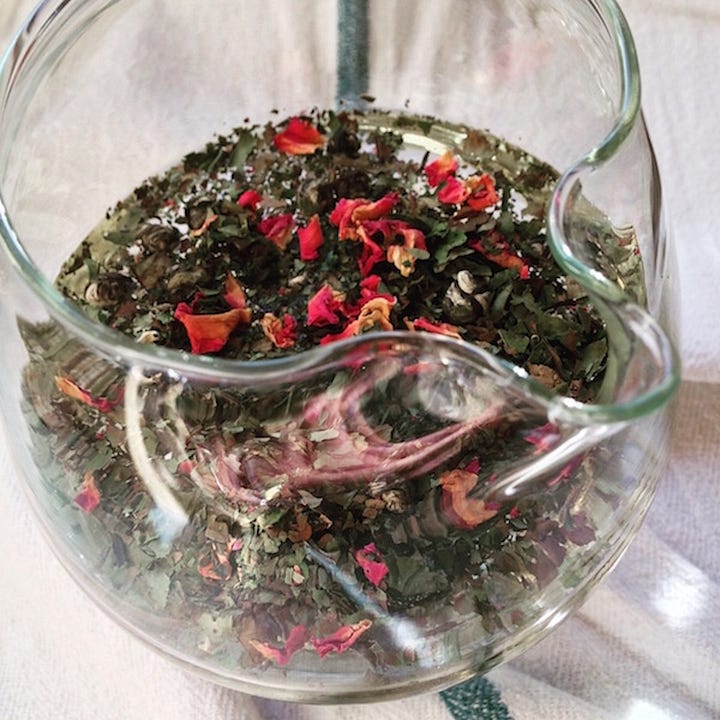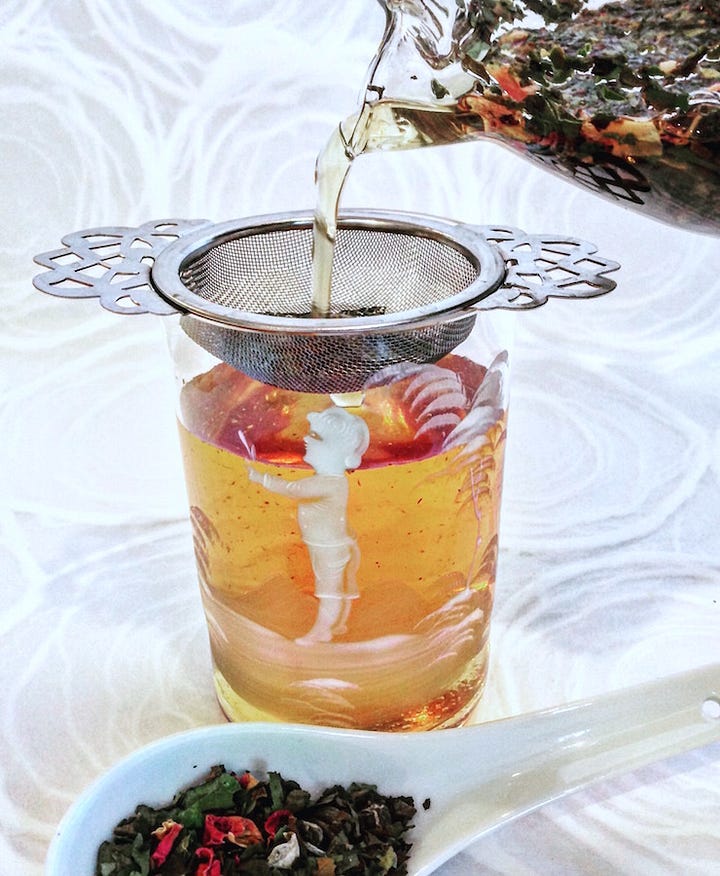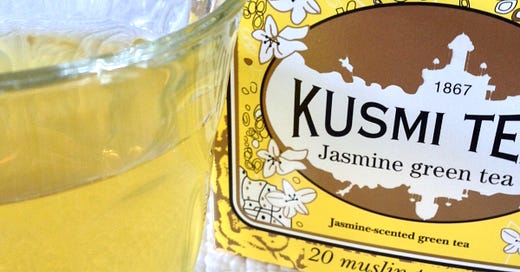How to Make Cold Brew Tea for The Smoothest Iced Tea
Even if you have never made your own beverages, cold-brew tea is one of the easiest and tastiest drinks you’ll ever make.
I like to cold brew oolong tea like this Ti Kuan Yin in the summer months—it’s delightful! Which makes me wonder, does anyone make their own beverages anymore?
Supermarkets dedicate multiple aisles to bottled drinks, which should already raise concerns. Have you checked the labels on these products recently? Many contain chemicals that result from prioritizing profits over health.
If you want to avoid the chemical swill typically found in bottled drinks produced by corporate greed, consider preparing your own beverages at home.
Typically, I only buy bottled water when I'm out and need to quench my thirst. I found it interesting that in Greece, by law, bottled water cannot cost more than 1 euro. Additionally, all their bottled water is mineralized, so drinking a lot in a short period, which is common in the summer heat, won't dilute your natural sodium levels and cause hyponatremia. I think this is a great idea—we should adopt it in America.
The cold brew trend
Boutique teahouses and even food service tea outlets now offer cold-brew options for iced tea. This popularity is due to the cold-brew method’s smooth and subtle flavor profile, making cold-brew tea a perfect summertime choice.
But how can you safely cold brew tea at home?
Cold brew tea vs. sun tea
Sun tea used to be quite popular. To steep, you would fill a clear glass pitcher with tea bags and room-temperature water and place it in the sun all day. That is until microbes were discovered growing in sun tea as the product sat outside on a hot summer day for hours.
The problem is sun tea does not get hot enough. Reaching 130 degrees Fahrenheit (55° C) is not hot enough to kill bacteria in the water or the tea leaves.
How to cold brew tea
Cold-brewed iced tea is as simple as sun tea but much safer when done correctly. Although, the brewing principle is the same. You’re eschewing the kettle along with the hot water to steep tea.
Cold-infused tea is just another way of extracting flavor from the tea leaves. It’s a longer and slower process, often 4 - 8 hours. The flavors are released slowly, resulting in smoother tea, leaving the bitterness behind.
A cold infusion results in a mellower, sweeter flavor because it doesn’t extract the same chemicals as hot-brewed tea, some of which can be bitter.
Important Note:
You MUST refrigerate cold-infused tea during the brewing process. Do not simply use cold water for brewing; then let the tea sit on the countertop to infuse.
Iced tea will keep fresh in the refrigerator for several days.
Steeping hot brewed tea vs. cold brew tea
There are distinct chemical differences between cold-brewed tea and hot-brewed tea. Tea leaves are typically steeped in boiling water for 3 - 7 minutes for hot tea.
The same pleasant chemicals extracted from steeping tea leaves in hot water are not pulled in cold water. To combat this extraction problem, the steep time and amount of tea leaves are drastically altered for cold brew. Compared to well-established hot-brew methods, cold-brew methods are still being developed.
Cold-brew tea produces a different flavor than traditional hot-brewed iced tea because it pulls out fewer catechins and tannins. Tea tannins are typically the substances that make tea taste bitter. It is not yet clear how cold brewing affects the caffeine content.
The cold-brew method gives you a refreshing, super-smooth tea for slow summer sipping. It isn’t bitter at all.
Cold brew tea chemistry
The brewing technique influences the taste of the tea and the concentration of flavanols in teas brewed from Camellia sinensis. The higher the temperature, the higher the diffusion speed. The hotter the water, the more catechins and tannins are drawn from the tea leaf.
The resulting liquor is very clear with a cold tea infusion, with little to no sediment at the bottom. This is because you are pulling out less of the heavier molecules, mainly tannins, that tend to settle out of the solution and sink to the bottom.
The cold brew method can be used to infuse any tea. This method works particularly well with green teas, including matcha. Herbal teas also work very well for cold brew.
Cold brew tea guide


Using blended teas for cold brew is a lovely option. Here I’ve cold brewed a white tea blended with jasmine and rosebuds. The flavors are so nice you don’t need to add any sweetener.
You can experiment with steeping times, but here is a general guide:
How long to cold brew tea:
Green, White and Oolong Teas can be infused in cold water in the refrigerator for 6 - 8 hours.
Black Teas can be infused in cold water in the fridge for 8 -12 hours.
Herbal Teas can be infused in cold water in the refrigerator for 8 -12 hours.
How much tea to use for cold brew:
The trick to extracting a fuller flavor is to use one and a half times the amount of tea leaves or bags you usually use for hot brewing.
If you use one teaspoon or 3 grams of loose-leaf tea for an 8-ounce hot brew, use one and a half teaspoons or 4.5 grams for a cold brew.
Cold brew green tea
Iced green tea is the perfect thirst quencher when it’s getting too steamy for hot tea. A lovely Jasmine Tea is the ideal green tea for cold brewing.
One of my favorite green teas is a naturally scented jasmine green tea from Kusmi Tea. I like the delicate jasmine flavor lightly extracted by the cold brewing method.
Kusmi tea makes a delicious green tea delicately scented with jasmine. The muslin tea bags are eco-friendly and make it exceedingly easy to cold brew the green tea in the refrigerator overnight.
Cold brewing green tea method:
Use one teabag or 4.5 gms per 8 ounces of cold filtered water.
Place tea bags or loose tea in a glass pitcher.
Combine tea and water and infuse in the refrigerated pitcher.
Refrigerate for 8 hours.
Remove tea and serve cold.
I love Kusmi’s organic Jasmine Green tea, which is a classic blend. The tea leaves are dried in direct contact with the jasmine petals, creating a light scent.
There is no such thing as instant cold-brewed tea
Buyer beware!
Have you seen the Lipton Cold Brewed Tea Bags in the supermarket?
Instant cold-brew tea is different from natural cold-brewed tea. You may have seen this in some popular Lipton tea bags. The instant variety is usually patented because the tea product is altered.
The commercial invention of instant cold brew encompasses a tea leaf product that rapidly infuses in cold water. The goal is to produce a beverage with the same color and flavor characteristics as hot-brewed iced tea beverages. Remember what I said about corporate swill?
Although these products contain tea leaves, they may include instant tea powder or coat the tea leaves with tea extracts.
If you read some of the patents, you will find that cold brew products may use powders, extracts, or colorants to infuse tea in cold water quickly. The goal is to produce an iced tea beverage product with color and flavor comparable to iced teas prepared by hot brewing methods.
The traditional method of black tea manufacture (perfected over thousands of years) of withering, heating, rolling, oxidizing, and drying tea leaves after plucking is bypassed and sped up using a Tannase/Peroxide Process.
This is all for the consumer’s convenience; you don’t have to wait 4-8 hours for your cold brew tea to infuse. And because consumers are an impatient bunch, Lipton has come to our rescue by chemically altering and speeding up the process with enzyme catalysts.
Cold brew matcha
The only tea that you can infuse instantly in cold water is matcha. Matcha is a powdered green tea made by finely grinding green tea leaves. It will infuse immediately into cold filtered water. I’ve even made it with sparkling water, which is quite refreshing. Add a little fresh fruit juice, and you have a lovely summer drink.
❤️❤️❤️ If you like this post, please let me know with a heart or comment. The algorithm likes a little love, and so do I.
Experiment and have fun!
It’s really hard to mess up cold-brew tea. But, natural cold-brew tea takes hours to infuse, not five minutes. Have patience. There are no shortcuts. Good things come to those who wait. 🙂






Great stuff Mary Ann! I’m a bit of a tea snob, I did not know about the cold brew process. I have to try that with some of my herbal teas! Thank you! 🙏🏼
I really enjoyed this article and will be making some cold brew herb tea tonight! Thank you Mary Ann